Abstract
Unpaved roads are essential as transportation infrastructure. These roads are traditionally built utilizing local soils and aggregates. The application of different materials to improve the strength and the overall performance of these road solutions has been investigated. This study focuses on the assessment of the suitability of reinforcing a fine soil using natural fibres from the forest value chain—specifically, pine needles—for unpaved forest roads. The resilient response of both unreinforced and reinforced soils was assessed with RL-CBR tests (California Bearing tests with repeated load) for different percentages of natural fibres incorporated into the soil. The force–penetration response, CBR value, recoverable and permanent displacements, and equivalent modulus were estimated. The effect of different load stages on the elastic response of both unreinforced and reinforced soils was also evaluated. The CBR values improved with the addition of pine needles; the best response was observed for specimens reinforced with 1% (mass) of these natural fibres (the CBR value increased by 45%). The equivalent modulus also was improved, showing that the stiffness of the soil increased with the inclusion of reinforcement. The findings imply that RL-CBR studies offer a promising method for obtaining important design parameters, especially for unpaved forest roads where investments in soil characterization are frequently limited.
1. Introduction
Currently, the demand for sustainable and resilient infrastructure are paramount. This paper analyses the case of unpaved forest roads, particularly focusing on considering the incorporation of pine needles as an alternative and sustainable solution, to promote a reduction of the need for maintenance works.
Traditional solutions for unpaved roads make use of natural resources, namely good-quality aggregates. Typically, unpaved roads are formed of a base layer overlaying the natural subgrade. The base layer is unbound and often is formed of good-quality aggregates. The quantity of natural aggregates needed in such traditional solutions impose large impacts on the environment. As an alternative to these materials, residues and byproducts should be considered [1]. The incorporation of these residues in new solutions can be beneficial, as it promotes circularity and sustainability. The advantages of such solutions include lower costs and reduced environmental impacts, as residues are reassessed to be utilised as building materials. For the case of unpaved forest roads, it is important to evaluate how alternative solutions respond to loads associated with logging operations [2]. To ensure forest roads exhibit an adequate and resilient response, when considering new solutions, it is essential to assess the road resistance to prevent (or at least minimise) deterioration problems [3].
Alternative solutions have been studied. For example, Pinho-Lopes [1] and Magalhães et al. [3] considered the use of industrial byproducts, assessing the soil behaviour, studying the performance of the solution, and conducting triaxial and California Bearing Ratio (CBR) tests, respectively.
Byproducts from the paper industry can also be incorporated into road solutions. Nienov et al. [4] created a mixture between clay soil, waste, and agglomerant in different conditions and assessed the compressive strength in relation to the proportions of this mixture. Cepriá et al. [5] considered the use of fly ash as an alternative hydraulic binder replacing the cement in road projects.
Most design methods available in the literature refer to paved roads. These are usually based on mechanical-empirical approaches. However, the procedure of this type of design method does not focus on granular layers, but on bound materials. To optimize the performance of granular layers, how they behave when subjected to cyclic traffic loads must be considered [6]. Given that, in most unpaved roads, the materials are unbound, this is a crucial aspect in design [7].
Developing a straightforward laboratory test that can provide relevant mechanical characteristics of granular materials is important. However, some of the test equipment is expensive, so it is valuable to find a more affordable test equipment and method that provides these mechanical characteristics of the materials [7]. A possible solution for a simple laboratory test that can provide relevant information is the repeated load CBR test (RL-CBR). One of the most often utilised parameters in road design, for both paved [8,9] and unpaved roads [10], is the CBR value, measured through CBR tests. The conventional CBR test is a penetration test, where a plunger moves at a constant axial displacement rate into a cylindrical soil specimen, formed of layers of compacted soil placed in a steel mould. There are different test standards for the CBR test; the most common is ASTM D 1883-07 [11]. While the conventional CBR test is only carried out with one load cycle (monotonic), the RL-CBR test is based on a standard CBR test with an increased number of load cycles [12]. There is no standardised procedure for the RL-CBR test; however, a number of studies including this type of test are available in the literature [6]. Table 1 summarises information from the literature on RL-CBR and the test conditions adopted, namely the base standard used (for the standard CBR test), mould dimensions (diameter; height), plunger diameter, the number of load cycles carried out, the axial displacement rate applied, the inclusion or not of a soaking phase of the specimens before testing, the penetration depth, the number of load stages, and the minimum stress reached in the unloading phase. The maximum load corresponds to the load required to achieve the penetration depth that represents the criterion for terminating the standard CBR test phase.

Table 1.
Summary of RL-CBR procedures emerging from the literature review carried out (no information is included when the base reference does not describe the corresponding element).
Mechanical properties, such as the resilient modulus (Mr) and the equivalent modulus (Eequ), can be obtained through cyclic triaxial and RL-CBR tests, respectively [2,7,12]. The resilient modulus (Mr), which is another quantity frequently utilised in road design, is the ratio between the axial deviatoric stress (σd) and resilient axial strain (εa) (Equation (1)), and it is typically quantified using cyclic triaxial tests [7]. The equivalent modulus (Eequ) represents an average response of the material in the mould, macroscopically, and is obtained by measuring the load and deformation during the loading and unloading cycle time of RL-CBR [12]. Araya et al. [12] proposed Equation (2) to estimate the equivalent modulus from RL-CBR. This equivalent elastic modulus (Eequ) depends on the following: Poisson’s ratio of the soil, υ; change in the stress applied through the plunger in a loading cycle (difference between the maximum and minimum applied load), Δσp (MPa); radius of plunger, r (mm); change in elastic displacement in a loading cycle, Δu (mm). Instead of referring to the resilient modulus of the material, the equivalent modulus is used to represent the stiffness of the unbound material [12]. However, presently, the equivalent modulus cannot be used directly in pavement design, since the loads and stresses applied in the test are higher than typical traffic loads. Therefore, it is necessary to correlate the results of a triaxial test (under the same test conditions) to estimate the corresponding resilient modulus [12]. Given that developing countries tend to have unpaved roads carrying a large number of vehicles [6], it is critical to define a test procedure to estimate relevant mechanical properties of unbound materials using less expensive equipment and test protocols that are simple to implement and of simple interpretation. In this context, the RL-CBR test is more adequate, affordable, and accessible than the triaxial test [7].
In this paper, an alternative solution for unpaved forest roads is analysed to promote sustainable, resilient solutions within a context of circularity. The solution consists of using natural fibres available in the forest, pine needles, as fibre reinforcement for a local soil. The mechanical properties of the developed solution were characterised using RL-CBR tests; different percentages of natural fibres were considered. To assess the response to repeated loading of the soil and soil–needles composite material, a stiffness modulus was estimated. The RL-CBR tests carried out included different load stages in order to analyse the influence of those stages on the elastic response observed.
2. Materials and Methods
2.1. Overview of the Experimental Programme
To evaluate the changes of the soil response due to the incorporation of natural reinforcement with pine needles, RL-CBR tests were performed on different quantities of reinforcement, herein designated as percentage of natural fibres, PNF, in mass. Table 2 summarises the experimental programme implemented. The materials studied are described in Section 2.2. and the procedure adopted for the RL-CBR tests is described in detail in Section 2.3.

Table 2.
Summary of the experimental programme carried out—RL-CBR tests on unreinforced soil and soil reinforced with a percentage of natural fibres (PNF) of 1% and 2%.
2.2. Materials
The conditions used for this set of experiments were control unreinforced soil specimens (PNF = 0%) and mixture of soil and 1% and 2% of natural fibres, relative to the mass of soil (PNF of 1% and 2%). Figure 1 illustrates the materials studied.

Figure 1.
Materials studied: (a) soil—sandy silt; (b) reinforcement—pine needles.
The soil originates from the Aveiro Lagoon, Portugal, and was collected from a salt pan wall. Considering the Unified Soil Classification System [18], the soil is considered a ML, sandy silt. This soil is mostly formed of fine particles (>0.074 mm), 65.7% precisely. Given the high percentage of fine particles, the Atterberg limits [19] of the soil were evaluated; its liquid limit, wL, is 35%, and its plastic limit, wP, is 25%, resulting in a plasticity index, IP, of 10%. Considering the conditions of modified Proctor tests (method C) [20], the optimum water content, wopt, and the corresponding maximum dry density, γdmax, were 13.9% and 18.09 kN.m−3, respectively. The grain size distribution of the soil is illustrated in Figure 2, determined according to [21].
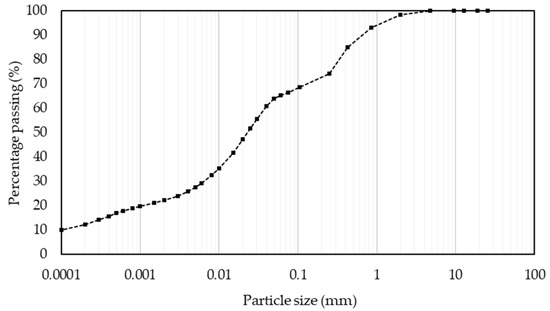
Figure 2.
Grain size distribution of the sandy silt collected from a salt pan wall of the Aveiro Lagoon, Portugal.
The reinforcement solution analysed in this study uses natural pine needles collected from stone pines, Pinus pinea, in the same region, Figure 1. With 52–60% cellulose, 13–15% lignin, 20% hemicellulose, and 5% of other extractives, this biodegradable material has a maximum tensile strength ranging between 35.8 and 36.94 MPa [22]. The physical characteristics of the natural reinforcement were analysed from a sample of 15 g in mass, concluding that the length of the pine needles varied from 60 to 180 mm, giving an average value of 117 mm; the average width was 0.87 mm, with values ranging between 0.62 and 1.11 mm. The ratio length/width (considering average values) was 134. The fibres were used in their natural state, after cleaning and an air-drying process. Damaged fibres were discarded.
2.3. Repeated Load CBR Tests (RL-CBR)
In the preparation of the specimens for testing, the soil, in its dry state, was mixed with the amount of water necessary to reach the optimum water content (wopt = 13.9%), simulating the compaction characteristics of the soil obtained from modified Proctor tests [20]. The soil was then kept in controlled conditions (temperature: 20 °C, relative humidity: 65%) for 24 h, allowing uniformization of the soil moisture. The amount of soil necessary for one specimen was then divided into 5 portions. For the reinforced specimens, each portion of soil was mixed with the correspondent percentage of pine needles to reach the desired PNF. Each layer was then placed inside the test mould and compacted with 25 blows of a rammer (4.54 kg; drop height: 457 mm). After the 5 layers had been compacted into the cylindrical mould, illustrated in Figure 3b (5) (diameter: 152 mm; height: 125 mm), the specimen underwent a 96 h soaking process. Throughout this process, it is possible to monitor the swelling of the specimen. For levels of PNF ≤ 1%, after that period, the swelling had stabilized; for PNF = 2%, the soaking process was terminated after 96 h, despite the swelling still varying. Between the end of the soaking process and the beginning of the RL-CBR test, a resting period of 15 min was given.
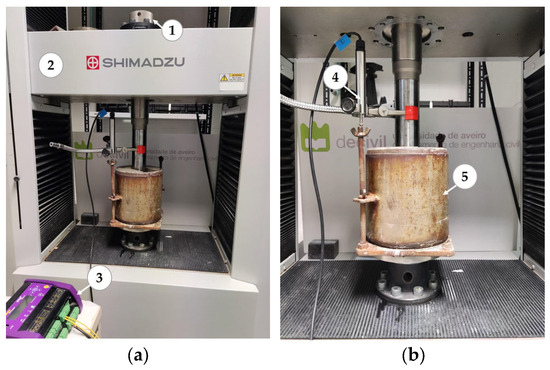
Figure 3.
RL-CBR test apparatus: (a) overview of the test system; (b) detail of the test setup (1—load cell; 2—mechanical load frame; 3—data logger; 4—LVDT; 5—mould with specimen).
After the specimen preparation, the mould was placed into the loading frame (Figure 3a, (2)) with 100 kN capacity. Throughout the test, an axial displacement was applied at a constant rate. The load cell (Figure 3a, (1)), 5 kN capacity, measures the force applied to the specimen, and the displacement linear variable differential transformer, LVDT with 25 mm stroke, (Figure 3b (4)), reads the displacement of the plunger. The data logger (Figure 3a, (3)) registers both variables in real time.
The RL-CBR tests carried out followed a sequence similar to that found in the literature (Table 1): an initial phase similar to a standard CBR test, followed by phases of repeated loading. The standard procedure adopted herein is described in LNEC E198 [23]. Relative to the procedure described in ASTM D 1883-07 [11], the test carried out differs in the following aspects: the plunger moves at an axial displacement rate of 1.00 mm.min−1 [23], instead of 1.27 mm.min−1 [11]; the steel cylinder mould has a diameter of 152 mm [23], rather than 152.4 mm [11].
The initial phase (phase 0) of the RL-CBR test involves the loading of the specimen at a constant axial displacement rate of 1.00 mm.min−1 up to a penetration of 2.5 mm (which is the reference value for calculating the CBR according LNEC E198 [23]) (Figure 4). Then, the maximum force reached is recorded and used as a reference for the remaining test. The load was applied at the upper surface of the specimen, using a 50 mm diameter plunger and under constant surcharge by three annular plates (24.52 kN each). This phase of the test is similar to the standard CBR test (with monotonic loading). Afterwards, the specimen is unloaded (at the same axial displacement rate of 1.00 mm.min−1) to the force of ~20 N, a value that was obtained from a trial CBR test on an unreinforced soil specimen. This load ensured that the plunger is still in contact with the specimen and was considered to be smaller than 5% of the maximum force applied during the trial test (28 N) and the pre-load defined in LNEC E198 [23] procedure (49 N).

Figure 4.
Force–penetration response of unreinforced soil (specimen 1) subjected to a standard CBR loading (phase 0), followed by 3 stages of repeated loading (phases 1 to 3).
Once this displacement is reached, phase 1 begins and several cycles of loading and unloading are applied until the criteria for defining the required number of cycles is met. The number of loading cycles was defined with the criterion presented in Equation (3). This criterion aimed at identifying when a resilient response was achieved and corresponds to, for 5 cycles, reaching an average plastic (permanent) displacement relative to the total plastic displacement of up to 1%. It led to a final number of loading cycles of 34 in phase 1 (total of 35 cycles for phases 0 and 1).
At the end of phase 1, another phase of repeated loading was started. This new loading stage (phase 2) corresponded to applying a maximum load (F2 in Figure 4) 30% larger than that of phase 1 (F1 in Figure 4), following the procedure described by [2]. Similarly, a third phase of repeated loading was applied, herein designated as phase 3 (with a maximum applied force, F3 in Figure 4), as in [2]. These phases (2 and 3) aimed at assessing whether the specimen acquires a different elastic response when subjected to different load stages. The same number of cycles was considered for each repeated load stage (35 cycles, with a total of 105 cycles).
The repetitions of the loading–unloading process for each phase (1 to 3) facilitate the evaluation of the soil response, as at a certain number of cycles, the soil starts having a stable recoverable deformation.
The response of the soil to repeated loading was assessed using a secant stiffness modulus, namely an equivalent elastic modulus (Eequ), using Equation (2) (from [12]), obtained using the secant modulus of the unloading path. For the soil studied, a Poisson’s ratio of 0.35 was assumed, which is within the range reported by Bardet [24].
3. Results and Discussion
3.1. CBR Test—Phase 0, Monotonic Loading
Figure 5 summarises the main results of the initial phase of the RL-CBR tests performed (phase 0, with monotonic loading). As mentioned before, this phase corresponds to the CBR standard test. For this reason, the force–penetration response (Figure 5a) and the CBR values (Figure 5b) for three specimens per condition are defined. Herein, the CBR values are obtained as the ratio of the force measured during the test for a value of penetration of 2.5 mm to the corresponding force for a standard material, typically a well-graded crushed stone (1355 kgf or 13.29 kN, defined in LNEC E198 [23]); the mean values of CBR are also included in Figure 5b.
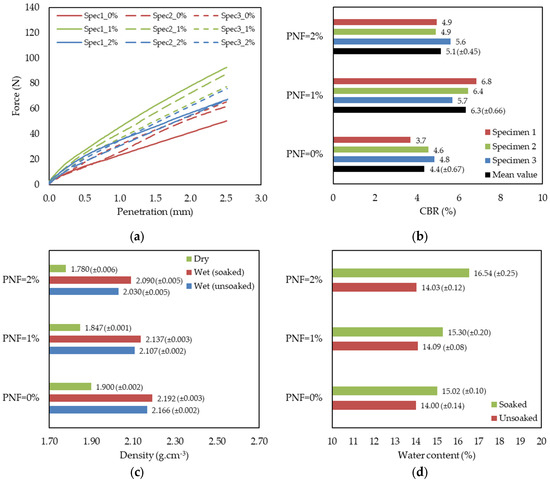
Figure 5.
Influence of the percentage of natural fibres (PNF) on monotonic loading phase (phase 0) of the CBR tests carried out: (a) force–penetration response; (b) CBR value (95% confidence interval in brackets); (c) density, before the test (average of three specimens; 95% confidence interval in brackets); (d) water content, before the test (average of three specimens; 95% confidence interval in brackets).
The force–penetration response and the CBR value are improved by the incorporation of the natural fibres in the soil. The inclusion of the pine needles led to a stiffer response for all reinforced specimens. The CBR value increased by 45% for PNF = 1% and 18% for PNF = 2%, compared to unreinforced soil. The specimens with 1.0% of pine needles (PNF = 1%) showed the best force–penetration response and the highest CBR values, indicating that this is the ideal PNF to improve the behaviour of this soil.
The redistribution of stresses and strains within the soil, induced by the inclusion of fibres, is the main cause of the improved soil response. This process occurs when the fibres transfer tensile forces to the soil through interaction mechanisms. However, this process is limited because the inclusion of fibres changes other relevant parameters, such as density and water content of the mix, which greatly influence its behaviour. The bearing capacity of fine soils is greatly influenced by their water content and density.
Figure 5c illustrates the density of the specimens, dry, wet before soaking (as prepared), and wet after soaking. The density of the reinforced specimens decreases, particularly for PNF = 2%. The reduced density can be attributed to several factors: (1) the fibres tend to restrict the packing of soil grains; (2) the excessive length of the fibres makes it difficult to mix them into the soil, resulting in heterogeneous orientation and spatial distribution of the fibres in the specimen; (3) part of the specimen is occupied by fibres that are less dense than the soil; (4) the compaction process is made more difficult due to the elastic behaviour of the fibres and the voids created next to the fibres, which absorb the impact forces generated by the rammer.
In contrast, the water content of the reinforced specimens is higher than in the unreinforced soil. This change is more pronounced for PNF = 2% (see Figure 5d). Possible reasons for the increase in water content include the following: (1) during the soaking process, water is absorbed by both the soil and fibres; (2) the needles, being hydrophilic with high absorbent capacity, expand more than the soil, creating preferential paths for water to flow through; (3) the increase in voids near the fibres also contribute to an increase in water flow into the specimens.
Higher PNF may have also reduced the mobilisation and transfer of stresses between the fibres and the soil, thereby decreasing the soil response. For instance, the agglomeration of fibres (overlapping in certain areas of a specimen) and the bending and breaking of some fibres contribute to decreasing the effectiveness of the mobilisation of the fibres. Furthermore, the water absorbed by the specimens during the soaking process reduces the effectiveness of the interaction mechanisms at the materials interface. The presence of water in the voids reduces effective stresses in the soil, decreasing frictional shear stresses and increasing sliding and ruptures at the interface. The combined effect of these parameters (and maybe others) may have led to the limited improvement observed for PNF = 2.0%.
3.2. CBR Test—Phases 1 to 3, Repeated Loading
The results of phases 1 to 3 of the RL-CBR tests allowed the assessment of the evolution of the permanent and recoverable displacements suffered by the specimens until a resilient response is reached, i.e., when the application of a load only causes elastic deformations in the material. Figure 6 illustrates the total displacement, as well as the recoverable (elastic) and permanent (plastic) components of the penetration displacement observed during each loading cycle (average for three specimens per condition).
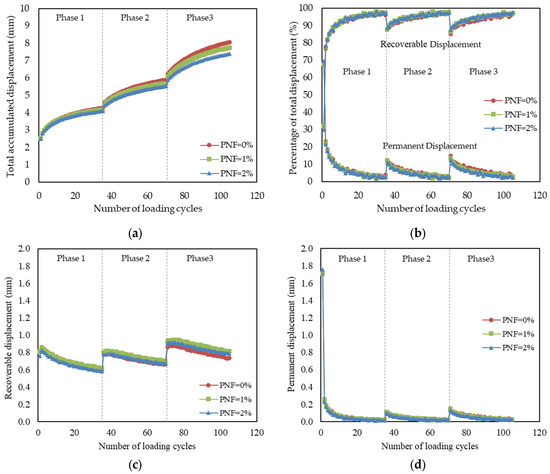
Figure 6.
Total, recoverable, and permanent displacement per cycle for different PNF (average of three specimens): (a) total accumulated displacement; (b) percentage of permanent and recoverable displacement; (c) recoverable displacement; (d) permanent displacement.
The largest component of the displacement is the recoverable portion, except for the first cycle (phase 0) in which most of the permanent displacement takes place. Both the recoverable and permanent displacement decreased as the number of cycles increased. In theory, the permanent displacement will tend to decrease towards zero while the recoverable displacement will also decrease until it reaches a constant minimum value as the number of loading cycles increases. Although the permanent displacement at the last cycle of phase 1 was very small (~0.02 mm), the corresponding recoverable displacement had not yet stabilised (after 35 loading cycles). This shows that the criterion used to define the number of cycles may need to be adjusted to achieve a constant elastic displacement, i.e., a resilient response. The total displacement of the unreinforced soil (PNF = 0%) was the largest and decreased with the inclusion of the natural reinforcement (pine needles). The lowest total displacement was observed for PNF = 2%. The presence of pine needles (PNF = 1% or PNF = 2%) did not change the proportion of recoverable and permanent displacement per cycle observed for the unreinforced solution (PNF = 0%).
A similar behaviour was observed for the following repeated load stages considered (phases 2 and 3). However, the total displacement due to phase 1 is substantially greater than that caused by phases 2 and 3 (Figure 6). This is because the plastic displacement at the beginning of the test (phase 0, monotonic loading) is extremely high and around 68 to 70% of the total displacement (depending on the PNF considered). A densification of the specimen below the plunger is observed, which influences the behaviour of the material and leads to a stiffer response. In the following cycles, the reduction in total displacement is substantial because much of the plastic displacement has already occurred. The total displacements caused by phases 2 and 3 are smaller because, as mentioned before, most of the plastic displacement has already occurred (the plastic displacement caused by the first cycle of phase 2 and of phase 3 was 12 to 14% of the total displacement (varied with PNF)).
To assess the soil response to repeated loading, an equivalent elastic modulus (Eequ) was estimated (Equation (2)). This parameter was calculated for all loading cycles of phases 0 to 3, although the most representative value refers to the last cycle of each phase (Eequ for the resilient response of the material). Figure 7 shows the evolution of Eequ with the number of loading cycles for the different conditions studied (PNF of 0%, 1%, and 2%).
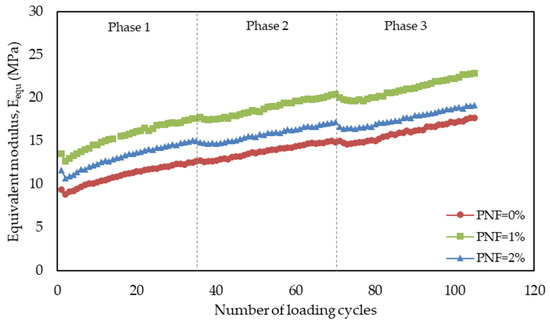
Figure 7.
Evolution of Eequ with the number of loading cycles for specimens of soil reinforced with different PNF: 0%, unreinforced; and with 1% and 2%, reinforced (average of three specimens).
The results obtained for phase 1 show that the equivalent modulus tends to increase with the number of load cycles. This parameter is influenced by the recoverable displacement and should reach a maximum constant value when this portion of the displacement is constant, i.e., when the material reaches its resilient response. As mentioned in relation to the recoverable displacement, regardless of the PNF considered, the equivalent modulus had also not yet stabilised at the end of phase 1 (i.e., after 35 load cycles), showing once again that the criterion used to define the number of cycles may need to be adjusted. For the unreinforced soil (PNF = 0%), at the end of phase 1, Eequ was 12.65 (±2.12)MPa (95% confidence interval in brackets), which is within the range of the Young’s modulus values reported by Bardet [24] for silts (2 to 20 MPa). The equivalent modulus at the end of phase 1 of the reinforced soil for both PNF of 1% and 2% increased relative to that of the unreinforced soil, which confirms the beneficial effect of the natural fibre reinforcement. This parameter also indicates that the inclusion of pine needles led to a stiffer response for all reinforced specimens. The higher equivalent modulus was observed for soil reinforced with PNF = 1%. After 35 cycles, i.e., at the end of phase 1, and relative to the unreinforced soil (PNF = 0%), the equivalent modulus increased by 58% for PNF = 1% and 22% for PNF = 2%.
The immediate effect of changing the magnitude of the load (phases 2 and 3) was to increase the displacement (both permanent and recoverable) suffered by the specimens. This effect is small but sufficient to reduce the equivalent modulus during the first 2–3 cycles of each phase. After that, the equivalent modulus rises again with a growth rate similar to that of the previous phase. Increasing the load does not seem to significantly modify the evolution of the equivalent modulus. However, it is not possible to guarantee that the resilient response of the material was achieved after 35 load cycles of phase.
Haghighi et al. [2] mentioned that the slope of the equivalent modulus–plunger stress relation can be used as an indication to investigate the failure of the material. According to the authors, if the slope decreases, the soil is approaching its maximum strength. The relation between Eequ and maximum force for each of the phases 1 to 3 is presented and analysed in Figure 8 (for all PNF). The slope of the trendline for each phase is reduced: 0.017 for phase 1, 0.015 for phase 2, and 0.010 for phase 3. This reduction indicates that the soil matrix is reaching its maximum strength, regardless of the fibre reinforcement.
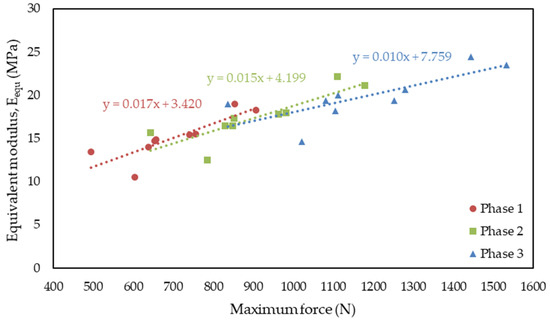
Figure 8.
Relation between Eequ and maximum force at each repeated load phase (1 to 3).
4. Conclusions
The main goal of this paper was to study the resilient response of a fine soil reinforced with natural fibres from the forest value chain (pine needles) and to evaluate their potential use on unpaved forest roads. Repeated load CBR tests (RL-CBR) were carried out on soil and soil–pine needles composite material (with 1 and 2% of needles incorporated). The force–penetration response, CBR value, recoverable and permanent displacements, and equivalent modulus were estimated. The effect of different load stages on the elastic response of both unreinforced and reinforced soil was also evaluated.
The results of the initial phase (phase 0) of the tests, which is equivalent to the standard CBR tests, allowed us to conclude the following:
- The force–penetration response and CBR value of the soil improved with the inclusion of pine needles.
- The best response was obtained for specimens with 1% of needles since the use of a higher percentage of incorporation did not result in further improvement. Several causes for this are outlined in the document.
The three phases of repeated loading carried out in RL-CBR tests showed the following:
- For each repeated load phase (1 to 3), as the number of cycles increased, the permanent displacement decreased, approaching a resilient response.
- The total displacement of the unreinforced soil was the largest and decreased with the inclusion of the natural reinforcement. The total displacements caused by phases 2 and 3 (i.e., with the increment of load applied to the specimen) were smaller because most of the plastic displacement had already occurred during the initial phase of the test (phase 0).
- The equivalent modulus quantified for the unreinforced soil was within the range of the Young’s modulus values reported in literature for the same type of soil (2 to 20 MPa for silts).
- The equivalent modulus of the soil reinforced with 1% or 2% of pine needles increased relative to that of the unreinforced soil, confirming the beneficial effect of the natural fibre reinforcement. This parameter also indicates that the reinforced specimens exhibited a stiffer response.
- The criterion used to define the number of cycles per repeated load phase may need to be adjusted to achieve a constant elastic displacement, i.e., a resilient response.
The experiments conducted in this work showed that for unpaved forest roads, where the investment in soil characterization is often very limited (and often unused), RL-CBR tests can be a promising (simple, quick, and affordable) approach to obtain current design parameters. However, there are some open questions that need to be further investigated. The effect of reinforcement geometry, soaking process, specimens dimensions, and of applying other types of repeated loads should be included in future studies. In addition, the test procedure should be revised regarding the number of cycles per repeated load phase to ensure that the resilient response can be properly assessed. It should also be noted that aspects related to the durability (effect of mechanical, physical, chemical, environmental agents, etc.) of the natural fibres considered in this study were not evaluated (as they were beyond the scope of the work).
Author Contributions
Conceptualization, D.M.C., J.M. and M.P.-L.; methodology, D.M.C., J.M. and M.P.-L.; validation, D.M.C., D.R., C.M., J.M. and M.P.-L.; formal analysis, D.M.C., J.M. and M.P.-L.; investigation, D.M.C.; resources, J.M. and M.P.-L.; data curation, D.M.C., J.M. and M.P.-L.; writing—original draft preparation, D.M.C., D.R., C.M. and M.P.-L.; writing—review and editing, D.M.C., D.R., C.M., J.M. and M.P.-L.; visualization, D.M.C., D.R., C.M. and M.P.-L.; supervision, J.M. and M.P.-L.; project administration, J.M. and M.P.-L.; funding acquisition, J.M. and M.P.-L. All authors have read and agreed to the published version of the manuscript.
Funding
This research was financially supported by the project TRANSFORM funded by the Portuguese Resilience Plan (PRR) through European Union—NextGenerationEU; FCT (“Fundação para a Ciência e a Tecnologia”-Portugal) is acknowledged through the project UIDB/04450/2020 (RISCO).


Institutional Review Board Statement
Not applicable.
Informed Consent Statement
Not applicable.
Data Availability Statement
Data are contained within the article.
Acknowledgments
The authors acknowledge Fábio Silva e Tomé Coutinho for collecting and providing the natural fibres (pine needles) used in this study.
Conflicts of Interest
The authors declare no conflicts of interest. The funders had no role in the design of the study; in the collection, analyses, or interpretation of data; in the writing of the manuscript, or in the decision to publish the results.
References
- Pinho-Lopes, M. Sand Reinforced with Recycled Cotton Textiles from Waste Blue-Jeans: Stress–Strain Response. Int. J. Geosynth. Ground Eng. 2022, 8, 59. [Google Scholar] [CrossRef]
- Haghighi, H.; Arulrajah, A.; Mohammadinia, A.; Horpibulsuk, S. A new approach for determining resilient moduli of marginal pavement base materials using the staged repeated load CBR test method. Road Mater. Pavement Des. 2018, 19, 1848–1867. [Google Scholar] [CrossRef]
- Magalhães, A.J.; Gomes, G.J.C.; Pires, P.J.M. Toward improved performance of unpaved roads: Laboratory tests and field investigation of a soil-byproduct base layer. Road Mater. Pavement Des. 2022, 23, 184–198. [Google Scholar] [CrossRef]
- Nienov, F.A.; Júnior, G.R.; Zampieri, L.Q.; Luvizão, G.; Lorenzatto, D.; Michelon, W.; Viancelli, A. Soil geotechnical improvement by using waste from the paper industry. Proc. Indian Natl. Sci. Acad. 2023, 89, 228–234. [Google Scholar] [CrossRef]
- Cepriá, J.J.; Orejana, R.; Miró, R.; Martínez, A.; Barra, M.; Aponte, D.; Baloochi, H. Waste paper ash as an alternative binder to improve the bearing capacity of road subgrades. In Eleventh International Conference on the Bearing Capacity of Roads, Railways and Airfields, 1st ed.; Hoff, I., Mork, H., Saba, R.G., Eds.; CRC Press: Boca Raton, FL, USA, 2021; Volume 1, pp. 172–181. [Google Scholar]
- Araya, A.A.; Huurman, M.; Molenaar, A.A.A. Investigation of the resilient behavior of granular base materials with simple test apparatus. Mater. Struct 2012, 45, 695–705. [Google Scholar] [CrossRef][Green Version]
- Wojciech, S.; Gluchowski, A.; Szymański, A. Determination of the Resilient modulus MR for the lime stabilized clay obtained from the repeated loading CBR tests. Ann. Wars. Univ. Life Sci. SGGW 2012, 44, 143–153. [Google Scholar]
- AASHTO. Guide for Design of Pavement Structures; American Association of State Highway and Transportation Officials: Washington, DC, USA, 1993. [Google Scholar]
- TRL ORN-31; A Guide to the Structural Design of Bitumen Surfaced Roads in Tropical and Subtropical Countries. Overseas Center Transport Research Laboratory: Crowthorne, UK, 1993.
- Giroud, J.P.; Han, J. Design method for geogrid-reinforced unpaved roads. I. Development of design method. J. Geotech. Geoenvironmental Eng. 2004, 130, 775–786. [Google Scholar] [CrossRef]
- ASTM D 1883-07; Standard Test Method for CBR (California Bearing Ratio) of Laboratory Compacted Soils. American Society for Testing and Materials: Philadelphia, PA, USA, 2007.
- Araya, A.A. Characterization of Unbound Granular Materials for Pavements. Ph.D. Thesis, Delft University of Technology, Delft, The Netherlands, 2011. [Google Scholar]
- Araya, A.; Molenaar, A.; Houben, L. Characterization of unbound granular materials using repeated load CBR and triaxial testing. Paving Mater. Pavement Anal. 2010, 355–363. [Google Scholar]
- Ševelová, L.; Florian, A.; Žák, J. Influence of Plunger Stress on Resilient Modulus of Forest Subgrade Soils Obtained from Cyclic CBR Test. Forests 2021, 12, 1456. [Google Scholar] [CrossRef]
- EN 13286-47; Unbound and Hydraulically Bound Mixtures-Part 47: Test Method for the Determination of California Bearing Ratio, Immediate Bearing Index and Linear Swelling. European Committee for Standardization: Brussels, Belgium, 2004.
- EN 1997-2; Geotechnical Design. Part 2: Ground Investigation and Testing. European Committee for Standardization: Brussels, Belgium, 2009.
- AS 1289.6.1.1; Australian Standard, Methods of Testing Soils for Engineering Purposes. Method 6.1.1: Soil Strength and Consolidation Tests–Determination of the California Bearing Ratio of a Soil–Standard laboratory method for a remoulded specimen. Standards Australia: Sydney, Australia, 1998.
- ASTM D2487-11; ASTM Internacional, Standard Practice for Classification of Soils for Engineering Purposes (Unified Soil Classification System). American Society for Testing and Materials: Philadelphia, PA, USA, 2011.
- ISO/TS 17892-12; Geotechnical Investigation and Testing–Laboratory Testing of Soil–Part 12: Determination of Atterberg limits. International Organization for Standardization: Geneva, Switzerland, 2004.
- ASTM D 1557-00; ASTM International, Standard Test Methods for Laboratory Compaction Characteristics of Soil Using Modified Effort (56,000 ft-lbf/ft3 (27,000 kN-m/m3)). American Society for Testing and Materials: Philadelphia, PA, USA, 2000.
- EN ISO 933-1; Tests for Geometrical Properties of Aggregates—Part 1: Determination of Particle Size Distribution—Sieving Method. European Committee for Standardization: Brussels, Belgium, 2012.
- Dinesh, K.B.; Kim, J. Mechanical and Dynamic Mechanical Behavior of the Lignocellulosic Pine Needle Fiber-Reinforced SEBS Composites. Polymers 2023, 15, 1225. [Google Scholar] [CrossRef] [PubMed]
- LNEC E198; Determinação do CBR. Laboratório Nacional de Engenharia Civil: Lisboa, Portugal, 1967. (In Portuguese)
- Bardet, J.-P. Experimental Soil Mechanics. Prentice Hall: Upper Saddle River, NJ, USA, 1997. [Google Scholar]
Disclaimer/Publisher’s Note: The statements, opinions and data contained in all publications are solely those of the individual author(s) and contributor(s) and not of MDPI and/or the editor(s). MDPI and/or the editor(s) disclaim responsibility for any injury to people or property resulting from any ideas, methods, instructions or products referred to in the content. |
© 2024 by the authors. Licensee MDPI, Basel, Switzerland. This article is an open access article distributed under the terms and conditions of the Creative Commons Attribution (CC BY) license (https://creativecommons.org/licenses/by/4.0/).